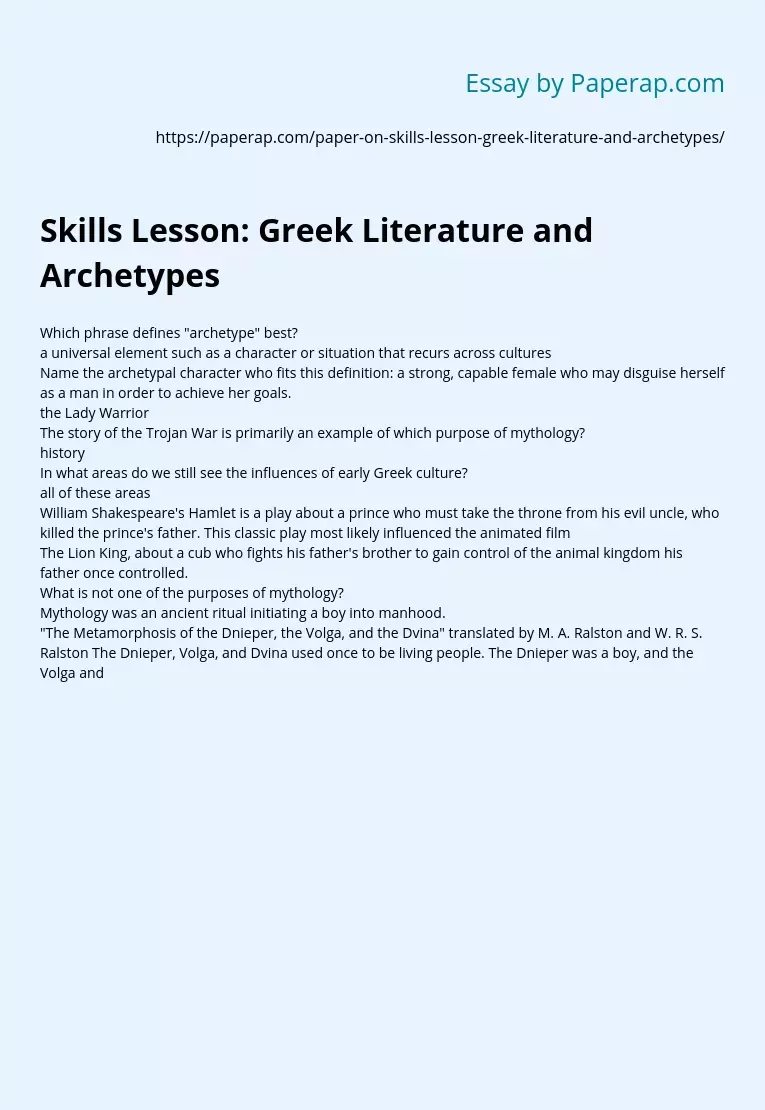Skills Lesson: Greek Literature and Archetypes
This classic play most likely influenced the animated film
translated by M. A. Ralston and W. R. S. Ralston
The Dnieper, Volga, and Dvina used once to be living people. The Dnieper was a boy, and the Volga and Dvina his sisters. While they were still in childhood they were left complete orphans, and, as they hadn’t a crust to eat, they were obliged to get their living by daily labor beyond their strength. “When was that?” Very long ago, say the old folks; beyond the memory even of our great-grandfathers.
Well, the children grew up, but they never had even the slightest bit of good luck.
Every day, from morn till eve, it was always toil and toil, and all merely for the day’s subsistence. As for their clothing, it was just what God sent them! They sometimes found rags on the dust-heaps, and with these they managed to cover their bodies. The poor things had to endure cold and hunger. Life became a burden to them.
One day, after toiling hard afield, they sat down under a bush to eat their last morsel of bread. And when they had eaten it, they cried and sorrowed for a while, and considered and held counsel together as to how they might manage to live, and to have food and clothing, and, without toiling, to supply others with meat and drink. Well, this is what they resolved: to set out wandering about the wide world in search of good luck and a kindly welcome, and to look for and find out the best places in which they could turn into great rivers—for that was a possible thing then.
Well, they walked and walked; not one year only, nor two years, but all but three; and they chose the places they wanted, and came to an agreement as to where the flowing of each one should begin. And all three of them stopped to spend the night in a swamp. But the sisters were more cunning than their brother. No sooner was Dnieper asleep than they rose up quietly, chose the best and most sloping places, and began to flow away.
When the brother awoke in the morning, not a trace of his sisters was to be seen. Then he became wroth, and made haste to pursue them. But on the way he bethought himself, and decided that no man can run faster than a river. So he smote the ground, and flowed in pursuit as a stream. Through gullies and ravines he rushed, and the further he went the fiercer did he become. But when he came within a few versts of the sea-shore, his anger calmed down and he disappeared in the sea. And his two sisters, who had continued running from him during his pursuit, separated in different directions and fled [Pg 219] to the bottom of the sea. But while the Dnieper was rushing along in anger, he drove his way between steep banks. Therefore is it that his flow is swifter than that of the Volga and the Dvina; therefore also is it that he has many rapids and many mouths.
Source: Ralston, M. A. and W. R. S. “The Project Gutenberg EBook of Russian Fairy Tales, by W. R. S. Ralston.” Project Gutenberg. Project Gutenberg, 22 Aug. 2007. Web. 25 Feb. 2011.
Which purpose of mythology does this story fulfill?
Leander was a youth of Abydos, a town of the Asian side of the strait [narrow ocean channel] which separates Asia and Europe. On the opposite shore, in the town of Sestos, lived the maiden Hero, a priestess of Venus. Leander loved her, and used to swim the strait nightly to enjoy the company of his mistress, guided by a torch which she reared upon the tower for the purpose. But one night a tempest arose and the sea was rough; his strength failed, and he was drowned. The waves bore his body to the European shore, where Hero became aware of his death, and in her despair cast herself down from the tower into the sea and perished.
Source: Bulfinch, Thomas. “Hero and Leander.” Project Gutenberg. Project Gutenberg, 27 Mar. 2002. Web. 25 Feb. 2011.
Which situational archetype fits this story best?
Skills Lesson: Greek Literature and Archetypes. (2018, Feb 02). Retrieved from https://paperap.com/paper-on-skills-lesson-greek-literature-and-archetypes/

